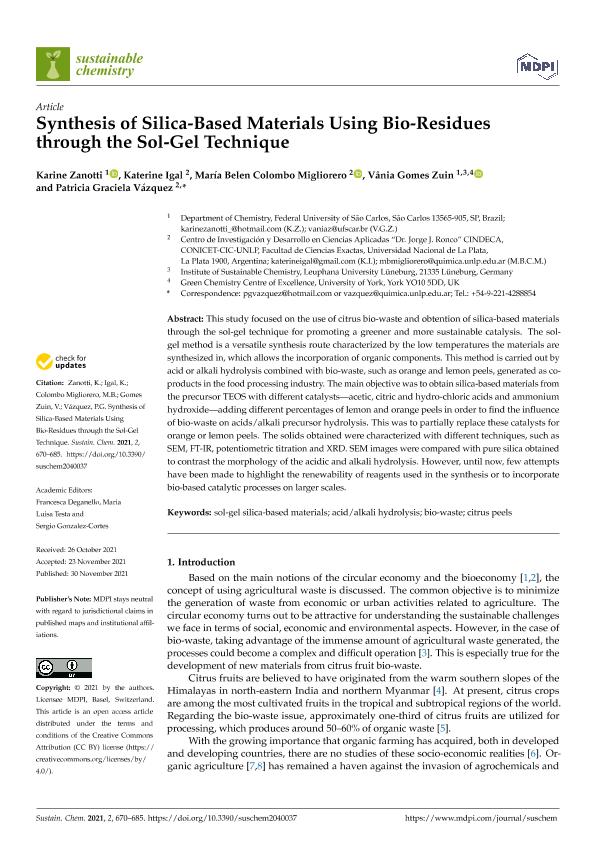Artículo
Synthesis of silica-based materials using bio-residues through the sol-gel technique
Zanotti, Karine; Igal, Katerine ; Colombo Migliorero, María Belén; Gomes Zuin, Vânia; Vázquez, Patricia Graciela
; Colombo Migliorero, María Belén; Gomes Zuin, Vânia; Vázquez, Patricia Graciela
 ; Colombo Migliorero, María Belén; Gomes Zuin, Vânia; Vázquez, Patricia Graciela
; Colombo Migliorero, María Belén; Gomes Zuin, Vânia; Vázquez, Patricia Graciela
Fecha de publicación:
11/2021
Editorial:
Multidisciplinary Digital Publishing Institute
Revista:
Sustainable Chemistry
e-ISSN:
2673-4079
Idioma:
Inglés
Tipo de recurso:
Artículo publicado
Clasificación temática:
Resumen
This study focused on the use of citrus bio-waste and obtention of silica-based materialsthrough the sol-gel technique for promoting a greener and more sustainable catalysis. The solgel method is a versatile synthesis route characterized by the low temperatures the materials aresynthesized in, which allows the incorporation of organic components. This method is carried out byacid or alkali hydrolysis combined with bio-waste, such as orange and lemon peels, generated as coproducts in the food processing industry. The main objective was to obtain silica-based materials fromthe precursor TEOS with different catalysts?acetic, citric and hydro-chloric acids and ammoniumhydroxide?adding different percentages of lemon and orange peels in order to find the influenceof bio-waste on acids/alkali precursor hydrolysis. This was to partially replace these catalysts fororange or lemon peels. The solids obtained were characterized with different techniques, such asSEM, FT-IR, potentiometric titration and XRD. SEM images were compared with pure silica obtainedto contrast the morphology of the acidic and alkali hydrolysis. However, until now, few attemptshave been made to highlight the renewability of reagents used in the synthesis or to incorporatebio-based catalytic processes on larger scales.
Archivos asociados
Licencia
Identificadores
Colecciones
Articulos(CIDEPINT)
Articulos de CENTRO DE INV EN TECNOLOGIA DE PINTURAS (I)
Articulos de CENTRO DE INV EN TECNOLOGIA DE PINTURAS (I)
Citación
Zanotti, Karine; Igal, Katerine; Colombo Migliorero, María Belén; Gomes Zuin, Vânia; Vázquez, Patricia Graciela; Synthesis of silica-based materials using bio-residues through the sol-gel technique; Multidisciplinary Digital Publishing Institute; Sustainable Chemistry; 2; 4; 11-2021; 670-685
Compartir
Altmétricas



